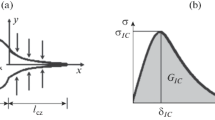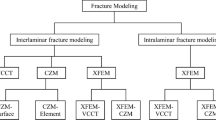The aim of this study is estimation of the effect of large deflections of a double-cantilever beam (DCB) on the accuracy of determination of the mode I interlaminar fracture toughness GIc of layered composites by using the nonlinear theory of bending of beams. The differential equation of the deflection curve of arm of the DCB specimen in the natural form was used to analyze the strain energy of the specimen and its strain energy release rate GI upon propagation of delamination under the action of cleavage forces at the ends of cantilevers. An algorithm for calculating the strain energy and its release rate in the DCB specimens is realized in the form of a MATLAB code. An experimental study was carried out on DCB specimens of a highly flexible carbon/epoxy laminate. The validity of the nonlinear model developed is demonstrated. The standard methods used to determine GIc are refined for the case of highly flexible specimens.






Similar content being viewed by others
References
J. G. Williams, “On the calculation of energy release rate for cracked laminates,” Int. J. Frac., 36, 101–119 (1988).
J. G. Williams, “Large displacement and end block effects in the DCB interlaminar test in modes I and II,” J. Compos. Mater., 21, No. 4, 330–347 (1987).
S. Hashemi, A. J. Kinloch, and J. G. Williams, “Corrections needed in double-cantilever beam tests for assessing the interlaminar failure of fibre-composites,” J. Mater. Sci. Lett., 8, No. 2, 125–129 (1989).
ASTM D5528. Standard Test Method for Mode I Interlaminar Fracture Toughness of Unidirectional Fiber Reinforced Polymer Matrix Composites (1994).
Fiber-Reinforced Plastic Composites - Determination of Mode I Interlaminar Fracture Toughness, GIC, for Unidirectionally Reinforced Materials, 15024, Int. Organization for Standardization, ISO (2001).
J. G. Williams, “End corrections for orthotropic DCB specimens,” Compos. Sci. Technol., 35, No. 4, 367–376 (1989).
B. N. Rao and A. R. Acharya, “Evaluation of fracture energy, GIc, using a double cantilever beam fibre composite specimen,” Eng. Fract. Mech., 51, No. 2, 317–322 (1995).
B. N. Rao and A. R. Acharya, “Maximum load at the initiation of delamination growth in a double cantilever beam specimen,” Zeitschrift fuer Metallkunde, 86, No. 6, 428–433 (1995).
V. A. Franklin and T. Christopher, “Fracture energy estimation of DCB specimens made of glass/epoxy: An experimental study,” Adv. Mater. Sci. Eng., ID 412601, 1–7 (2013).
Z. Suo, G. Bao, and B. Fan, “Delamination R-curve phenomena due to damage,” J. Mech. Phys. Solids, 40, 1–16 (1992).
D. Kaute, H. R. Shercliff, and M. F. Ashby, “Modeling of fibre bridging and toughness of ceramic matrix composites,” Scripta Metall. Mater., 32, 1055–1060 (1995).
A.-M. Yan, E. Marechal, and H. Nguyen-Dang, “A finite element model of mixed-mode delamination in laminated composites with an R-curve effect,” Compos. Sci. Technol., 61, 1413–1427 (2001).
S. Hashemi, J. Kinloch, and J. G. Williams, “Mechanics and mechanisms of delamination in a polyether sulphone-fibre composites,” Compos. Sci. Technol., 37, 429–462 (1990).
V. Tamuzs, S. Tarasovs, and U. Vilks, “Progressive delamination and fiber bridging modeling in double cantilever beam composite specimen,” Eng. Fract. Mech., 68, 513–525 (2001).
K.-S. Sohn, S. Lee, and S. Baik, “Analysis of bridging stress effect of polycrystalline alumina using double cantilever beam method,” Acta Mater., 45, 3445–3457 (1997).
J. E. Lindhagen and L. A. Berglund, “Application of bridging-law concepts to short-fibre composites. Part 1: DCB test procedures for bridging law and fracture energy,” Compos. Sci. Technol., 60, 871–883 (2000).
S. O. Fernberg and L. A. Berglund, “Bridging law and toughness characterization of CSM and SMC composites,” Compos. Sci. Technol., 61, 2445–2454 (2001)
A. Szekreґnyes and J. Uj, “Advanced beam model for fibre-bridging in unidirectional composite double-cantilever beam specimens,” Eng. Fract. Mech., 72, 2686–2702 (2005).
F. Nilsson, “Large displacements aspects on fracture testing with double cantilever beam specimens,” Int. J. Fract., 139, 305–311 (2006).
V. Tamužs, S. Tarasovs, U. Vilks, and I. Rumkovska, “Development of test methods for adhesion measurements of flexible elastic materials,” Proc. ECCM-13 (2008). ULR: <http://www.escm.eu.org/docs/eccm13/0811.pdf> (subm. date: 12.03.2015)
R. G. Boeman, D. Erdman, L. Klett, and R. Lomax, “A practical test method for mode I fracture toughness of adhesive joints with dissimilar substrates,” SAMPE-ACCE-DOE Adv. Compos. Conf., Detroit, MI, September 27–28 (1999). ULR: <http: // web.ornl.gov / ~ webworks/cpr/pres/104246.pdf> (subm. date: 10.04.2015)
C. Prasanth, S. Ravindranath, A. Samraj, and T. Manikandan, “Mode-I fracture analysis of thermally aged of glass and glass-carbon hybrid composites,” Int. J. Innov. Technol. Explor. Eng., 3, No. 10, 84–89 (2014).
V. Pavelko, “Behavior of thin-film-type delamination of layered composite in post-buckling,” Adv. Mater. Research., 774–776, 1312–1321 (2013).
V. Pavelko, “Analytical 1D model of delamination development and strength of layered composite beam in postbuckling,” Key Eng. Mater., 627, 325–328 (2014).
V. Pavelko, “Application of the nonlinear model of a beam for investigation of interlaminar fracture toughness of layered composite,” Key Eng. Mater., 665 , 273–276 (2015).
S. P. Timoshenko and J. M. Gere, Theory of Elastic Stability, McGraw-Hill, New York (1961), Chap. 2.
Author information
Authors and Affiliations
Corresponding author
Additional information
Translated from Mekhanika Kompozitnykh Materialov, Vol. 52, No. 3, pp. 491-`506 , May-June, 2016.
Rights and permissions
About this article
Cite this article
Pavelko, V., Lapsa, K. & Pavlovskis, P. Determination of the Mode I Interlaminar Fracture Toughness by Using a Nonlinear Double-Cantilever Beam Specimen. Mech Compos Mater 52, 347–358 (2016). https://doi.org/10.1007/s11029-016-9587-y
Received:
Published:
Issue Date:
DOI: https://doi.org/10.1007/s11029-016-9587-y




